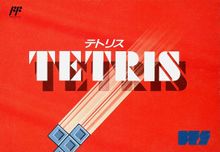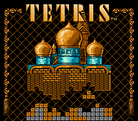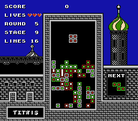Tetris (Famicom)
| Tetris | |
|---|---|
 | |
| Developer(s) | Bullet Proof Software |
| Publisher(s) | Bullet Proof Software |
| Platform(s) | Family Computer |
| Release | December 22, 1988 |
| Gameplay info | |
| Next pieces | 1 |
| Playfield size | 10 × 20 |
| Hold piece | No |
| Hard drop | Hard only |
| Rotation system | Unique with random spawns |
Tetris for the Family Computer (Famicom) is a port of the Japanese home computer versions. It is the first home console port of Tetris. Originally published under an incorrect license, the game led to Henk Rogers's purchase of the Tetris license on multiple platforms, which later led directly to further Nintendo releases.
At the time of its release, there was no standard on how to map the controls of Tetris to a video game controller (this was also before the release of the arcade version made by Tengen). Because of this, this version is infamous for its control scheme, which mapped down to rotate, and A to hard drop, the opposite of most later versions which have down for drop and A for rotate. This was due to adapting the keyboard control scheme from the computer ports directly to the control pad on the Famicom.
On October 1st, 2018 the game was re-released as part of the AtGames Legends Flashback. It has an updated copyright screen and remapped controls (up/B for rotate, down/A/C for hard drop). On November 1st, 2019, it was re-released on the updated Legends Flashback, Legends Ultimate Arcade, and the Adventure Flashback Blast!.
Gameplay
Gameplay is based on BPS's Japanese computer versions. The aim is to clear a series of stages. There are 6 rounds of 10 stages, and there are 25 lines to clear to advance to the next stage, with the screen cleared after each stage. Each stage has increasing gravity, while each round has increasing garbage height. The player has three lives, allowing two top outs without ending the game.
After clearing stage 9 on a given round the game continues to level 0 on the next round. If round 5 stage 9 is cleared the game shows an ending screen then loops back to round 5 stage 0.
The speeds of each stage are as follows:
| Stage | Frames per row |
|---|---|
| 0 | 80 |
| 1 | 65 |
| 2 | 50 |
| 3 | 40 |
| 4 | 32 |
| 5 | 25 |
| 6 | 20 |
| 7 | 17 |
| 8 | 15 |
| 9 | 13 |
| ||||||||

